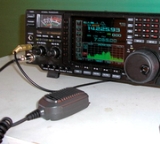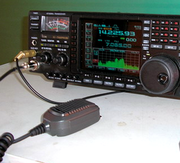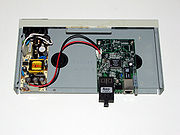
Transceiver
Encyclopedia
A transceiver is a device comprising both a transmitter
and a receiver
which are combined and share common circuitry or a single housing. When no circuitry is common between transmit and receive functions, the device is a transmitter-receiver. The term originated in the early 1920s. Technically, transceivers must combine a significant amount of the transmitter and receiver handling circuitry
. Similar devices include transponder
s, transverter
s, and repeater
s.
 In radio
In radio
terminology, a transceiver means a unit which contains both a receiver and a transmitter. It was quite common to have these units separated. Ham radio operators
can build their own equipment and it is always easier to design and build a simple unit having one of the functions, transmitting or receiving. Almost every modern amateur radio equipment is now a transceiver but there is an active market for pure radio receivers, mainly for shortwave listening
operators. An example of a transceiver would be a walkie-talkie
, or a CB radio.
. The micro electronic circuits in the digital-RF architecture work at speeds up to 100 GHz. The objective in the design was to bring digital domain closer to the antenna, both at the receive and transmit ends using software defined radio (SDR). The software-programmable digital processors used in the circuits permit conversion between digital baseband
signals and analog RF.
, the handset contains the transmitter and receiver for the audio and in the 20th century was usually wired to the base unit by tinsel wire
. The whole unit is colloquially referred to as a "receiver." On a mobile telephone or other radiotelephone
, the entire unit is a transceiver, for both audio and radio.
A cordless telephone
uses an audio and radio transceiver for the handset, and a radio transceiver for the base station
. If a speakerphone
is included in a wired telephone base or in a cordless base station, the base also becomes an audio transceiver in addition to the handset.
A modem
is similar to a transceiver, in that it sends and receives a signal, but a modem uses modulation and demodulation. It modulates a signal being transmitted and demodulates a signal being received.
 Transceivers are called Medium
Transceivers are called Medium
Attachment Units (MAU
s) in IEEE 802.3
documents, which were widely used in 10BASE2
and 10BASE5
Ethernet
networks. Fibre-optic gigabit
and 10 Gigabit Ethernet
utilize transceivers known as GBIC
, SFP
, SFP+, XFP, and XAUI
.
General
Transmitter
In electronics and telecommunications a transmitter or radio transmitter is an electronic device which, with the aid of an antenna, produces radio waves. The transmitter itself generates a radio frequency alternating current, which is applied to the antenna. When excited by this alternating...
and a receiver
Receiver (radio)
A radio receiver converts signals from a radio antenna to a usable form. It uses electronic filters to separate a wanted radio frequency signal from all other signals, the electronic amplifier increases the level suitable for further processing, and finally recovers the desired information through...
which are combined and share common circuitry or a single housing. When no circuitry is common between transmit and receive functions, the device is a transmitter-receiver. The term originated in the early 1920s. Technically, transceivers must combine a significant amount of the transmitter and receiver handling circuitry
Electronic circuit
An electronic circuit is composed of individual electronic components, such as resistors, transistors, capacitors, inductors and diodes, connected by conductive wires or traces through which electric current can flow...
. Similar devices include transponder
Transponder
In telecommunication, the term transponder has the following meanings:...
s, transverter
Transverter
A transverter is a radio frequency device that consists of an upconverter and a downconverter in one unit. Transverters are used in conjunction with transceivers to change the range of frequencies over which the transceiver can communicate....
s, and repeater
Repeater
A repeater is an electronic device that receives asignal and retransmits it at a higher level and/or higher power, or onto the other side of an obstruction, so that the signal can cover longer distances.-Description:...
s.
Radio technology

Radio
Radio is the transmission of signals through free space by modulation of electromagnetic waves with frequencies below those of visible light. Electromagnetic radiation travels by means of oscillating electromagnetic fields that pass through the air and the vacuum of space...
terminology, a transceiver means a unit which contains both a receiver and a transmitter. It was quite common to have these units separated. Ham radio operators
Amateur radio
Amateur radio is the use of designated radio frequency spectrum for purposes of private recreation, non-commercial exchange of messages, wireless experimentation, self-training, and emergency communication...
can build their own equipment and it is always easier to design and build a simple unit having one of the functions, transmitting or receiving. Almost every modern amateur radio equipment is now a transceiver but there is an active market for pure radio receivers, mainly for shortwave listening
Shortwave listening
Shortwave listening is the hobby of listening to shortwave radio broadcasts located on frequencies between 1700 kHz and 30 MHz. Listeners range from casual users seeking international news and entertainment programming to hobbyists immersed in the technical aspects of radio reception and DXing...
operators. An example of a transceiver would be a walkie-talkie
Walkie-talkie
A walkie-talkie is a hand-held, portable, two-way radio transceiver. Its development during the Second World War has been variously credited to Donald L. Hings, radio engineer Alfred J. Gross, and engineering teams at Motorola...
, or a CB radio.
RF Transceiver
The RF Transceiver uses RF modules for high speed data transmissionData transmission
Data transmission, digital transmission, or digital communications is the physical transfer of data over a point-to-point or point-to-multipoint communication channel. Examples of such channels are copper wires, optical fibres, wireless communication channels, and storage media...
. The micro electronic circuits in the digital-RF architecture work at speeds up to 100 GHz. The objective in the design was to bring digital domain closer to the antenna, both at the receive and transmit ends using software defined radio (SDR). The software-programmable digital processors used in the circuits permit conversion between digital baseband
Baseband
In telecommunications and signal processing, baseband is an adjective that describes signals and systems whose range of frequencies is measured from close to 0 hertz to a cut-off frequency, a maximum bandwidth or highest signal frequency; it is sometimes used as a noun for a band of frequencies...
signals and analog RF.
Telephony
On a wired telephoneTelephone
The telephone , colloquially referred to as a phone, is a telecommunications device that transmits and receives sounds, usually the human voice. Telephones are a point-to-point communication system whose most basic function is to allow two people separated by large distances to talk to each other...
, the handset contains the transmitter and receiver for the audio and in the 20th century was usually wired to the base unit by tinsel wire
Tinsel wire
Tinsel wire is a form of low voltage electrical wire used when maximum mechanical flexibility is required. It is commonly found in cords used for telephones, especially the handset cords, and in headphones. Because of its extreme flexibility it is much more resistant to failing as a result of metal...
. The whole unit is colloquially referred to as a "receiver." On a mobile telephone or other radiotelephone
Radiotelephone
A radiotelephone is a communications system for transmission of speech over radio. Radiotelephone systems are not necessarily interconnected with the public "land line" telephone network. "Radiotelephone" is often used to describe the usage of radio spectrum where it is important to distinguish the...
, the entire unit is a transceiver, for both audio and radio.
A cordless telephone
Cordless telephone
A cordless telephone or portable telephone is a telephone with a wireless handset that communicates via radio waves with a base station connected to a fixed telephone line, usually within a limited range of its base station...
uses an audio and radio transceiver for the handset, and a radio transceiver for the base station
Base station
The term base station can be used in the context of land surveying and wireless communications.- Land surveying :In the context of external land surveying, a base station is a GPS receiver at an accurately-known fixed location which is used to derive correction information for nearby portable GPS...
. If a speakerphone
Speakerphone
A speakerphone is a telephone with a microphone and loudspeaker provided separately from those in the handset. This device allows multiple persons to participate in a conversation...
is included in a wired telephone base or in a cordless base station, the base also becomes an audio transceiver in addition to the handset.
A modem
Modem
A modem is a device that modulates an analog carrier signal to encode digital information, and also demodulates such a carrier signal to decode the transmitted information. The goal is to produce a signal that can be transmitted easily and decoded to reproduce the original digital data...
is similar to a transceiver, in that it sends and receives a signal, but a modem uses modulation and demodulation. It modulates a signal being transmitted and demodulates a signal being received.
Ethernet

Transmission medium
A transmission medium is a material substance that can propagate energy waves...
Attachment Units (MAU
Medium Attachment Unit
A Medium Attachment Unit is a transceiver which converts signals on an Ethernet cable to and from Attachment Unit Interface signals.On original 10BASE5 Ethernet, the MAU was typically clamped to the Ethernet cable...
s) in IEEE 802.3
IEEE 802.3
IEEE 802.3 is a working group and a collection of IEEE standards produced by the working group defining the physical layer and data link layer's media access control of wired Ethernet. This is generally a local area network technology with some wide area network applications...
documents, which were widely used in 10BASE2
10BASE2
10BASE2 is a variant of Ethernet that uses thin coaxial cable , terminated with BNC connectors...
and 10BASE5
10BASE5
10BASE5 was the original commercially available variant of Ethernet.For its physical layer it used cable similar to RG-8/U coaxial cable but with extra braided shielding. This is a stiff, diameter cable with an impedance of 50 ohms , a solid center conductor, a foam insulating filler, a shielding...
Ethernet
Ethernet
Ethernet is a family of computer networking technologies for local area networks commercially introduced in 1980. Standardized in IEEE 802.3, Ethernet has largely replaced competing wired LAN technologies....
networks. Fibre-optic gigabit
Gigabit Ethernet
Gigabit Ethernet is a term describing various technologies for transmitting Ethernet frames at a rate of a gigabit per second , as defined by the IEEE 802.3-2008 standard. It came into use beginning in 1999, gradually supplanting Fast Ethernet in wired local networks where it performed...
and 10 Gigabit Ethernet
10 Gigabit Ethernet
The 10 gigabit Ethernet computer networking standard was first published in 2002. It defines a version of Ethernet with a nominal data rate of 10 Gbit/s , ten times faster than gigabit Ethernet.10 gigabit Ethernet defines only full duplex point to point links which are generally connected by...
utilize transceivers known as GBIC
GBIC
A gigabit interface converter is a standard for transceivers, commonly used with Gigabit Ethernet and fibre channel in the 1990s...
, SFP
SFP transceiver
The small form-factor pluggable or Mini-GBIC is a compact, hot-pluggable transceiver used for both telecommunication and data communications applications. It interfaces a network device mother board to a fiber optic or copper networking cable...
, SFP+, XFP, and XAUI
XAUI
XAUI is a standard for extending the XGMII between the MAC and PHY layer of 10 Gigabit Ethernet . XAUI is pronounced "zowie", a concatenation of the Roman numeral X, meaning ten, and the initials of "Attachment Unit Interface"...
.
See also
- 4P4C, de facto standard connectorElectrical connectorAn electrical connector is an electro-mechanical device for joining electrical circuits as an interface using a mechanical assembly. The connection may be temporary, as for portable equipment, require a tool for assembly and removal, or serve as a permanent electrical joint between two wires or...
for telephone handsets - DuplexDuplex (telecommunications)A duplex communication system is a system composed of two connected parties or devices that can communicate with one another in both directions. The term multiplexing is used when describing communication between more than two parties or devices....
, 2-Way Communications Capability - For the difference between optical transponders and optical transceivers, see Transponder (optical communication)
External articles
Patents- , John Stone StoneJohn Stone StoneJohn Stone Stone was an American mathematician, physicist and inventor. He labored as an early telephone engineer, was influential in developing wireless communication technology, and holds dozens of key patents in the field of "space telegraphy".-Early years:Stone was born in Dover, now Manakin...
, "Apparatus for simultaneously transmitting and receiving space telegraph signals" - , A. J. Kloneck, "Simultaneous sending and receiving system"
- , A. J. Kloneck, "Simultaneous sending and receiving system"
- , C. Le G. Fortescue, "Combined wireless sending and receiving system"
General
- 7 MHz SSB TRANSCEIVER 7 MHz SSB TRANSCEIVER
- Homebrew HF transceivers Homebrew HF transceivers

